The Soyuz Rocket's History
by Hugo Filmer, Form V
24 min. read — February 26, 2021
On Sunday, February 15, 2021, a Soyuz 2-1a rocket carrying a Progress automated resupply spacecraft bound for the International Space Station lifted off from Baikonur Cosmodrome in remote Kazakhstan.
There was nothing remarkable about this launch, which is part of what makes it special. Combined, all members of the R-7 family, of which the Soyuz series is the modern offshoot, have launched more than a thousand times, and the family can truly be considered the workhorse of the Soviet (later Russian) space fleet. The R-7 family is also the longest-serving rocket family; to put things into perspective, the first launch of the R-7 missile, the world’s first ICBM, took place on March 3, 1957. In other words, at the time of writing, this basic rocket design has been with us for more than 60 years, achieving a number of world-firsts along the way.
The roots of the Soyuz can be traced back even further, to the German V-2. At the close of World War II, the Americans, British, and Soviets scrambled to claim the engineers and technology behind the world’s most advanced missile at the time. The Americans made off with the bulk of the German technicians, while the Soviets got the production and launch facilities for this “wonder weapon” (the poor Brits got almost nothing).
The few German engineers the Soviets had managed to capture were put to work under one of the most significant Soviet aerospace engineers, Sergei Korolev, and the team set about disassembling the V-2s the USSR had managed to capture and then reproducing them, creating a rocket known as the R-1. This design was essentially identical to the V-2, although it was produced with local materials and gave the Soviets valuable experience in rocket design. The next step was the more powerful and capable R-2, a newer design based on the R-1. However, something more would be needed for the R-7. This was to be the world’s first true intercontinental ballistic missile, capable of carrying a 5-ton warhead some 8000 kilometers. This extraordinarily ambitious requirement came about from a series of estimations made by Soviet nuclear scientists about future weapon sizes; Soviet statesman Vyacheslav Malyshev demanded a missile capable of carrying warheads of this size anywhere on the planet. Design work began in late 1953, and preliminary design was completed in mid-1954.
It soon became clear that the single-stage design of the R-1 and 2 would not suffice: as fuel tanks emptied, they would need to be shed in order to keep the dead weight off the mammoth rocket and enable it to travel the distance. Korolev’s team came up with a design featuring four boosters that would provide most of the thrust at liftoff and fire for about 2 minutes, and a center “sustainer” engine, which would start at the same time as the boosters but last for another 3 minutes. The boosters would be curved and pointed so that, together with the core, the rocket would be conical for the first stage of flight. There was another problem, however: that of combustion instability. As the size of a rocket engine is scaled up, it becomes more difficult to keep combustion going steadily (the United States solved this problem in its F-1 engines for the Saturn V with a complex series of baffles on the propellant injector plate). The foremost engine designer in the Soviet Union at the time, Valentin Glushko, came up with a revolutionary solution that would later be adopted on many other soviet rockets: four separate, smaller combustion chambers, all fed from a single turbopump. He had two variations of this basic design: the slightly more powerful RD-107 (Ракетный Двигатель-107, or Rocket Engine-107), used on the 4 boosters, and the slightly more efficient RD-108 used on the sustainer core. Glushko, while a brilliant engineer, had a rocky relationship with Korolev. During Stalin’s purges of the ‘30s, the two were forced to denounce each other on false charges of sabotaging the progress of Soviet technology, and Korolev had not fared well in the harsh Siberian prison camps. Vasily Mishin, Korolev’s deputy, had put forward the idea of using small steering, or “vernier,” engines for control of the huge missile, which massed nearly 300 tons fully fueled. Glushko was strongly opposed to this design over the more conventional steering vanes inserted into the engine exhaust. He argued the design was already outlandish enough, and any more innovation would cause further delays and reliability issues. Ultimately Mishin won out, and so two vernier engines were placed on each RD-107, and four on the RD-108.
By 1955, the final launch site in the Khazak desert, dubbed “Baikonur Cosmodrome,” had been selected, and in May 1957, the first R-7 missile was ready for its first test flight. On May 5, the first R-7 blasted off into the sky from the barren, dust-swept wastes of the Khazak steppes. The rocket followed a normal test trajectory, although its range was diminished by the added weight of measuring equipment that had to be added for this first flight, and the flight continued until it was terminated about 100 seconds after liftoff: there was a fire in the engine bay and one of the boosters had separated too early. After several aborted attempts at launch with a second missile, the third broke up 30 seconds into flight. An incorrectly installed battery had caused early booster separation. Finally, on August 21, 1957, the R-7 had its first successful test flight. The test warhead reached the target in Kamchatka and provided a much-needed victory to Korolev’s exhausted team.
After another successful test launch, mostly focused on improving the warhead design, the launch date for Sputnik 1, the shining silver sphere of a satellite, was set. Upon hearing vague rumors about a possible American satellite launch on October 5, Korolev’s team rushed to have their orbital launch attempt on October 4. The missile-become-launcher was hastened to the pad on October 3, and, on October 4, 1957, the space age began.
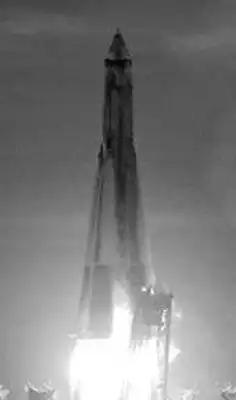
However, Sputnik 1 was certainly not the end of the R-7’s history. About a month later the same basic design would go on to launch Sputnik 2, carrying the first animal, Laika, into orbit, but this “Sputnik” rocket, as it was known, did not have the capability for sending satellites into deep space, nor did it have the ability to launch a person into orbit. For that, an upper stage would be needed to provide an extra boost to the payload. The addition of this upper stage, powered by the RD-0105 engine, which was based off one of the vernier thrusters on the RD-107, would enable the rocket to reach these lofty performance goals. The new stage was to be called “Blok-E” (confusingly, the propulsion system for the Soviet LK lunar lander was also known as Blok-E). The upgraded R-7 would be known as “Luna.” However, there were yet more design challenges to overcome. Starting a rocket stage in space is tricky due to what is called ullage. Ullage, a term originally from beer brewing, refers to the unfilled space in a container. On Earth’s surface, the propellant inside a tank will naturally settle at the bottom due to the pull of gravity. However, in the freefall of space, the propellant will spread out and float around. If it is not “settled” at the bottom of the tanks, then the engine will not draw in fuel and oxidizer when it tries to start and will fail. Therefore, the stage needed some positive acceleration before starting its engine. The Soviets solved this with an approach they would continue to use in later rockets known as “hot-staging.” The core and the upper stage were connected by a latticelike structure which would allow exhaust gases from the upper stage to escape. When the center RD-108 had nearly depleted its fuel, the upper stage would ignite with the core still attached. As soon as the RD-108 shut down, the two stages would separate. This approach ensured that there was always acceleration, so the RD-0105’s propellant would remain settled.
After three failed Luna attempts, the first satellite to reach the vicinity of the moon, Luna 1, was successfully launched on January 2nd, 1959. The probe was originally intended to impact the moon, but a small error in a radio antenna on the ground caused the upper stage to shut down slightly too late, giving the spacecraft an extra 42 meters per second of velocity. This caused it to merely fly past the moon at close range before going into orbit of the sun. The mission was still regarded as a success because of its world-first nature, and the probe, now orbiting the sun, was called a “new planet” and dubbed “Mechta,” or “Dream,” by Korolev . After another failure during a launch attempt for a lunar impactor probe, Luna 2 became the first spacecraft to impact the moon in September 1959, and Luna 3 would immediately follow up the success, launching on October 4, 1959, exactly two years after Sputnik 1, onto a trajectory that looped around the moon. Luna 3 was able to transmit the first-ever images of the far side of the moon back to Earth. You may note that both the rocket and the probes were named “Luna;” Soviet rockets were often given names based on their first major payloads, which can cause some confusion.
The next derivative of the R-7 was a fairly minor upgrade to the RD-0105, known as the RD-109. This design improved the performance and the reliability of the engine for the first manned space flights of the Soviet Union. The engine upgrade, as well as some minor improvements to the Blok-E upper stage, was completed by the end of 1960, and the new rocket, dubbed “Vostok,” was ready to launch the Vostok capsule designed by Mikhail Tikhonravov’s team. The Vostok spacecraft consisted of a pressurized spherical capsule where the cosmonaut would remain for the entire flight, as well as a small retro module for deorbiting the spacecraft and recovering its pilot after mission completion. The rigorous test program began with the launch of Korabl-Sputnik 1 on May 15, an empty capsule which had difficulties in the deorbit phase. From this point onwards, the Soviets launched pairs of dogs to test the environment inside the capsule. The second development launch failed and the third succeeded, but the fourth and fifth also failed. Finally, after two more perfect flights with dogs, the combination was considered reliable enough. On April 12, 1961, the first man, Yuri Gagarin, was launched into orbit on a Vostok rocket. He completed a single orbit of Earth before the retro motor was fired, and after a rough reentry through the atmosphere, ejected from the capsule seven kilometers above the surface, as planned, before parachuting down to land at Smelovka. The R-7 had done it again, and the Soviets continued to stay ahead.
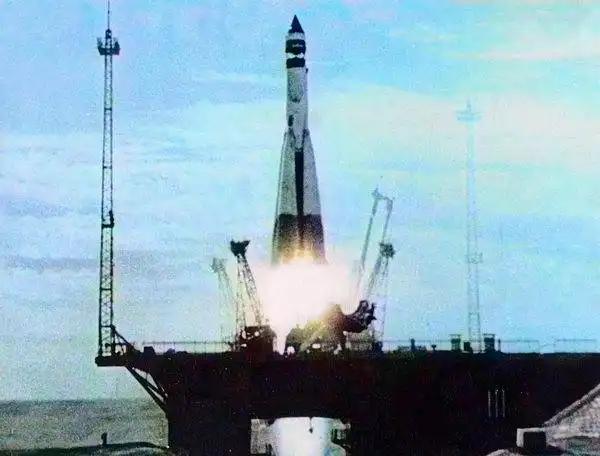
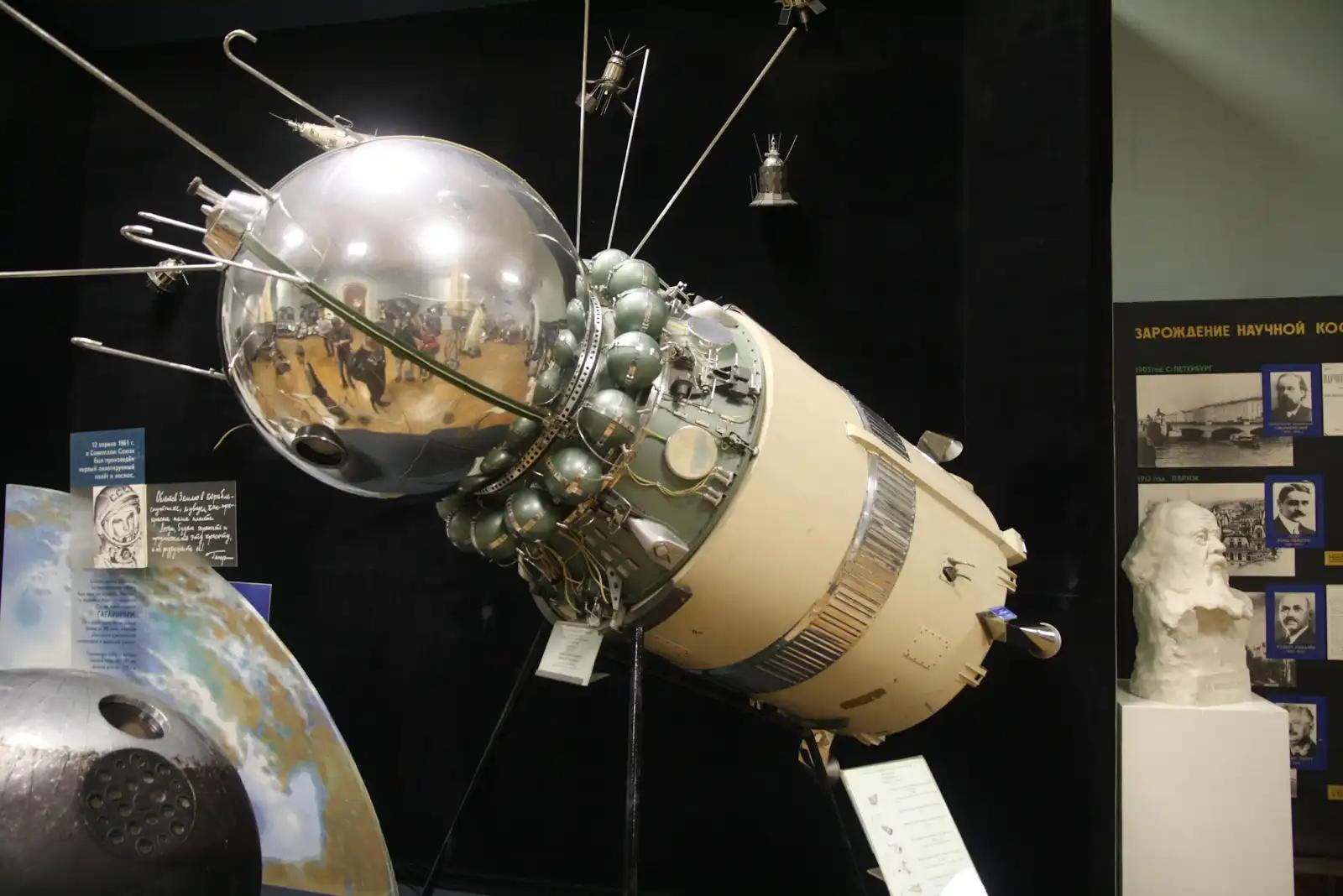
The R-7 design was nowhere near finished, though. The next upgrade would be a radical change to the upper stages of the rocket. On January 15, 1960, Korolev signed off on the next step, a rocket capable of launching probes to Mars and Venus, what would eventually be known as “Molniya,” or “Lightning.” To get the required performance while sticking to the R-7 framework, Molniya would have two upper stages: first, Blok-I, which would use an engine adapted from the upper stage of the R-9 missile, the RD-0106. This new engine, called the RD-0107, was somewhat similar in layout to the RD-108, using four main combustion chambers fed by a single turbopump, as well as four vernier thrusters on the outside which gimballed for control. The designer of the RD-0106 and 7 was none other than Semyon Kosberg, who had also designed the RD-0105/109. This powerful new upper stage was designed to carry the entire fourth stage, known as Blok-L, to orbit, and featured some advanced technology. First, there was the ullage section, a truss adapter that also carried orientation thrusters for pointing Blok-L accurately before it ignited to send its payload into deep space. The ullage section also contained two solid rocket motors to settle the fuel in the stage before firing the brand-new S1.5400 engine.
To explain what made this engine, designed by Korolev’s team, so special, we have to go a little deeper into engine design. The pressure in a combustion chamber is quite high, and so propellant needs to be supplied at an even higher pressure, since fluids flow from high pressure to low pressure. Therefore, we need a pump system to deliver the propellant from the low-pressure tanks to the high-pressure chambers. The different ways in which different kinds of pump systems operate are called “cycles.” One common and simple cycle, used on the RD-0107 alongside many other engines, is known as the “gas-generator” cycle. In this design, a small amount of fuel and oxidizer are burned in an auxiliary combustion chamber, known as a “preburner,” that is part of what is essentially a mini rocket engine. The nozzle of this engine is pointed at a turbine, and the hot gases released spin the turbine. In a gas-generator design, the combustion products are then dumped over the side. To keep the turbine from overheating, the mixture of the fuel and oxidizer is not optimal; there is too much fuel or too much oxidizer. However, dumping this propellant-rich exhaust over the side seems like something of a waste, right? Wouldn’t it be more efficient to pipe the unburnt fuel or unspent oxidizer into the main combustion chamber? This is the thought process that leads to the “staged-combustion” cycle.
There are several engineering difficulties with this cycle. Ideally, the propellant in excess would be the fuel, to avoid large amounts of hot, extremely reactive oxygen flowing through the metal plumbing of the engine and oxidizing it. The fuel the Soviets were using was kerosene, though, which releases a significant amount of carbon soot when burned in excess. If the fuel-rich exhaust was pumped back into the combustion chamber, the soot would clog the plumbing and destroy the engine. Therefore, the Soviets would have to take the hard route and build their preburner to run oxygen-rich, ensuring that the kerosene would combust completely without any soot. The second issue was one of pressures: the chamber pressure in the preburner would need to be incredibly high to ensure that the exhaust could still enter the main combustion chamber after powering the turbopump. Combined, these two challenges led top American rocket scientists to deem the oxygen-rich cycle impossible, and so the first staged-combustion engine America developed, the RS-25 that powered the Space Shuttle, used liquid hydrogen fuel instead, which did not have the same soot issues kerosene did. Advanced Soviet metallurgy was needed, but alloys resistant to oxidation and high temperatures were developed, and on October 10, 1960, the first Molniya, carrying the world’s first staged-combustion engine as well as the world’s first Mars probe, Mars-1a, lifted off.

Molniya was, unfortunately, a troubled rocket. The rushed development program led to a long string of failures in the new upper stages that would not abate until 1965; in fact, none of the Molniya-launched Moon, Mars, or Venus probes would prove successful. In an attempt to improve the reliability of the rocket, a new version with significantly improved control systems and a more reliable engine for the Blok-I, the RD-0108, was developed starting in 1963. After six flights, this engine was upgraded again to the RD-0110, which would become a mainstay of the R-7 series. The first flight of this new version, the Molniya-M, would take place on 19 February 1964, and it would continue flying all the way into the 21st century; the last launch was on September 30th, 2010. Molniya-M was mainly used for launching Molniya communications satellites and Oko early warning spacecraft, but also launched several important scientific missions; Luna 9, the first spacecraft to make a soft landing on the moon, was launched on a Molniya-M on January 31st, 1966.
While the Soviets certainly weren’t slouching, they were up against a formidable foe in the space race: the United States. By 1964, the States had begun to put together a spacecraft far more advanced than the early, primitive Mercury capsule. To reflect its role as a two-person ship, this new capsule design was named “Gemini.” While the USSR’s Vostok was more advanced than Mercury, it could still only seat one astronaut. In February 1964, Korolev was ordered by the USSR’s government to begin work on increasing the crew capacity of Vostok from one to three, naturally to upstage the US. Like the Molniya program, the new capsule design, “Voskhod,” would have to be rushed. Based so heavily on a one-person craft, Voskhod was extremely cramped inside, even though the astronauts wore no space suits in order to save on the limited space. To make more space and save weight, there would be no ejection seats. If there was a failure, the astronauts were doomed.
The heavier Voskhod spacecraft needed a larger launch vehicle to get it into orbit. To accomplish this, the Voskhod rocket was essentially a Molniya-M with the last stage removed. The RD-0108 was essential for any hope of crew safety; the unreliable -0107 would not suffice for a man-rated vehicle. This approach of reusing the Molniya hardware would also save precious time. On October 12, 1964, the first crewed Voskhod was launched; the crew only had four months of training. Sergei Korolev shook as the rocket took off. Should there be a failure somewhere, there was no chance of escape. The three astronauts on board would be dead men. Thankfully, the experience gained with all previous R-7 variants improved the reliability of the system, and the launch went perfectly.
While Voskhod was ahead of America’s Gemini, it was more of a publicity stunt than anything else. The spacecraft’s systems were far less advanced than Gemini. There would only be one more crewed launch of Voskhod, and it was another illusion to amaze the rest of the world. Cosmonaut Alexei Leonov would perform the first spacewalk, exiting out of a further-modified Voskhod equipped with a rubber airlock tube to drift in the heavens. An unmanned Voskhod was launched to test the airlock system, but exploded while testing pressurizing and depressurizing. There was no time for a do-over. Once again, Soviet cosmonauts would have to put their lives on the line.
The flight started off well, with a successful launch. Leonov was able to easily leave the spacecraft. While he floated in the heavens, he enjoyed a spectacular view of the Earth below him. However, while attempting to reenter the spacecraft, cosmonaut Alexei Leonov became stuck due to his inflating suit. To fully enter the Voskhod, he had to reduce the pressure inside his suit while struggling in the cumbersome and bulky outfit. It was an exhausting process, and he was nearly trapped outside the Voskhod. Even after reentering the capsule, the troubles had not ended. The automatic control system for properly orienting the spacecraft for re-entry had failed. The astronauts had to lie across seats to manually align the Voskhod, and the inaccuracy of this method meant that the astronauts landed not in the designated zone, but in the wilderness of Siberia. It took rescue teams a day to reach them. All in all, while the cosmonauts were recovered successfully, their flight was marred by near-disaster.
But the Voskhod program was a mere distraction to make the Americans think the USSR was more advanced than it really was. The true next-generation Soviet spacecraft was named Soyuz, and it would be capable of far more than either Vostok or Voskhod. This new craft would use two spherical capsules: one which the three crew members would inhabit for liftoff and landing, and one for on-orbit operation. It would be much roomier than Voskhod, and, crucially, had the capability for rendezvous and docking with another capsule or even a space station in orbit. This would be necessary for a Soviet moon mission. To support this new spacecraft, a new launcher, also named “Soyuz,” was needed. Soyuz would also unify a variety of older versions of the R-7. It was very similar in design to the previous Voskhod rocket, with the upgraded RD-0110 from the previous Molniya-M used to assure crew safety, as well as a third stage of generally more advanced design. Improvements were made throughout to enable the design to lift the heavier Soyuz spacecraft, including a special selection process for the first-stage engines to ensure high performance. Another crew safety mechanism was a new escape tower system, containing a powerful solid rocket motor. In case an earlier stage of the rocket failed, the motor would light and pull the cosmonauts away from the doomed vehicle to a safe landing. The telemetry system was also improved and the weight reduced. However, the first flight of the Soyuz rocket on November 28, 1966 would be marred by the death, early in the year, of Sergei Korolev. He would be remembered as a cheerful, romantic man and the father of the Soviet space program.
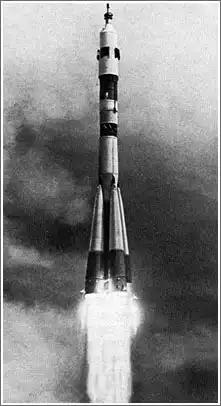
Meanwhile, the Soyuz spacecraft was having its own difficulties. Many of the systems on board were faulty, as was discovered in May 1966 ground testing. Even as the scheduled Soyuz 1 launch on April 23, 1967 drew near, there were still several important defects. But with Korolev gone, no one had the influence to persuade the Soviet authorities to call off the launch. On the day, cosmonaut Vladimir Komarov entered the spacecraft and prepared for liftoff. While the launch itself went perfectly, problems quickly developed in orbit. A solar panel, crucial for providing power, would not deploy. The orientation control system was not working. There were communication difficulties between Komarov and stations on the ground. By the 17th orbit, things were seriously going wrong. Miraculously, the retro-motors in the tumbling craft worked, but Komarov had no control over descent. Then, disaster! The main parachute jammed and failed to deploy properly. Then, the backup chute became tangled in the main. With no way of slowing his craft down, Komarov impacted the Earth’s surface at nearly 200 m/s. After an ensuing fire, only charred fragments of bone remained. His loss, combined with Korolev's, would severely set the Soviet space program back. Ultimately, it would not reach the moon.
As the cold war began to wind down and with the space race near-complete, Soviet technological development in space was not about to stop. A new version of the Soyuz rocket was coming into service, one which would participate in the ASTP, or Apollo-Soyuz test project. Intended as a diplomatic endeavor, an American Apollo spacecraft would dock with a Soviet Soyuz. This was the perfect opportunity to improve and unify differing Soyuz variants, which had been drifting apart and made production more complex and expensive. The new, standardized Soyuz would be known as Soyuz-U. There were upgrades to nearly every aspect of the rocket, including the engines and the ground equipment. In addition, the propellant in the core stage was chilled to increase density and burn time. Design work began in 1969, but due to changing specifications for military satellites to be launched on the new type, it was not completed until 1971. Manufacturing started in the fall of 1972. On May 18, 1973, the first Soyuz-U flew, carrying a Yantar spy satellite into orbit. On July 15, 1975, Soyuz-U lifted the Soviet Soyuz into orbit to dock with Apollo, signifying the end of the space race and an easing of tensions between the world’s superpowers. Soyuz-U would go on to be the definitive Soyuz variant, launching 763 times, the most of any orbital rocket. It was also extremely reliable for those launches, and, in 1979, it launched an astounding 47 times, a record that still stands today.
While the Soyuz-U would remain the definitive version of Soyuz for over two decades, it was also modified for some payloads. In late 1982, the first Soyuz-U2 launched. While all R-7-derived rockets had used RP-1, essentially a high grade of kerosene, as their fuel, the U2 switched over to a similar fuel called syntin. Syntin was a synthetic substitute to kerosene with fewer impurities that was slightly more efficient, thus allowing a couple hundred more kilograms to be brought to orbit. It was used for many launches, for both crew and cargo, to the Salyut 7 and Mir stations. However, the U2 was retired in 1996; following the collapse of the USSR, syntin was comparatively too expensive to produce in order to justify the slight performance increase. Altogether, Soyuz-U2 launched 72 times.
Other variants of the basic Soyuz-U included two with new upper stages. Of these, the more important is Soyuz-U-Fregat. Development of the “Fregat” upper stage, which would allow Soyuz-U to launch payloads into higher orbits, even on interplanetary voyages, as was done with Mars Express and Venus Express, and also deploy multiple satellites in the same launch. Fregat also uses storable propellants, which can be kept liquid at room temperature, to make extended operation in space possible. The stage consists of six overlapping spheres. Four are filled with propellant, while two are used for instrumentation and electronics. The stage takes up only a small amount of room in a payload fairing, leaving plenty for the satellites. Development started in 1992, based on previous experience with the Soviet lunar probes. Fregat began launching on Soyuz-U in 2000 and has flown continuously since then on all versions of Soyuz.
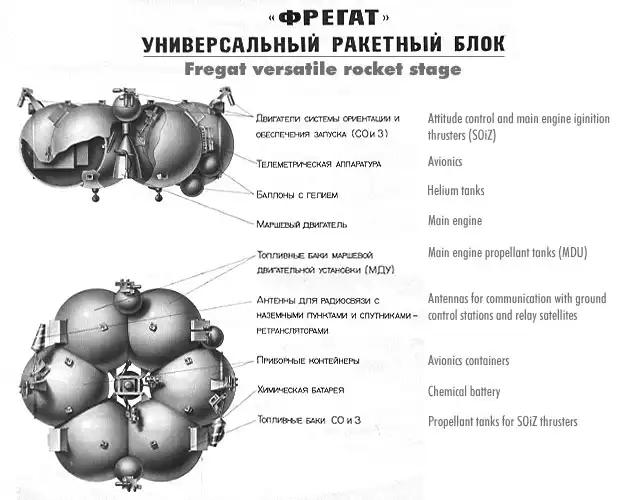
With the turn of the century, a long and slow modernization process for Soyuz was in order. This process would be carried out through three phases. The first of these was the replacement of the Soyuz-U with the Soyuz-FG. Design work on this new variant of the R-7 family started in 1993, but it took until 2000 for the first launch. FG was a minor upgrade to the engines of the first stage; the injector system, which controls the flow of propellant into the combustion chamber, was overhauled. Propellant was more finely atomized, which meant smoother combustion with less vibration and more efficient operation. The new engines were known as RD-107A and 108A. Aside from that, the vehicle was largely identical to Soyuz-U. The similarities unfortunately included the guidance system, which was old and Ukranian. During the Russian-Ukranian conflict of 2014, the United States government had to beg Ukraine to supply the guidance hardware, which was necessary for launching NASA astronauts on the Soyuz-FG following the retirement of the Space Shuttle in 2011. For all this, Soyuz-FG was only intended to be a quick interim solution in the transition to the latest Soyuz variant, Soyuz-2.
Soyuz-2 is the long-time-coming reaction to the collapse of the USSR, and aims to move production of all components to within Russia’s borders. The Soyuz-2 program was split into two stages. The first was the Soyuz 2-1a, which kept the hardware from Soyuz-FG, but replaced the old Ukranian analog guidance system with a much more flexible digital guidance system made in Russia. This alone allowed for small improvements in payload, due to a more optimized launch trajectory, as well as the ability to perform a roll maneuver in flight. The previous control system could not perform a roll maneuver, meaning expensive rotating pads were necessary. The reliability of the guidance system was also improved by this change. During this time, Roscosmos, the Russian space agency, was approached by Arianespace, the European launch sales company, which was looking for a medium-lift rocket to complement its small Vega and large Ariane 5 rockets following the retirement of the aging Ariane 4. After final approval in 2005, the construction for the Soyuz-2 launch pad in Kourou, French Guiana (Arianespace’s launch site) began in 2007 and was completed in 2011. For Kourou, a slightly modified version of the Soyuz 2-1a was designed, called the Soyuz-ST. The changes mainly relate to Kourou’s tropical climate and adapting the rocket to tracking infrastructure already at the site. On April 9, 2020, the first Soyuz 2-1a carrying a crewed Soyuz spacecraft launched
The second step, Soyuz 2-1b, was significantly more impactful. The old RD-0110, a holdover from the Molniya-M, was replaced by an entirely new engine, the RD-0124. Unlike the 0110, the 0124 uses a closed cycle, similar to the S1.5400, while maintaining the same thrust as the older engine. This makes the upper stage much more efficient, and increases the payload capacity significantly; the new 0124 also lacks vernier engines and gimbals the four main chambers instead. The first flight of this rocket was on July 26 with a classified payload for the Russian government. Besides the new upper stage, it is identical to the Soyuz 2-1a.
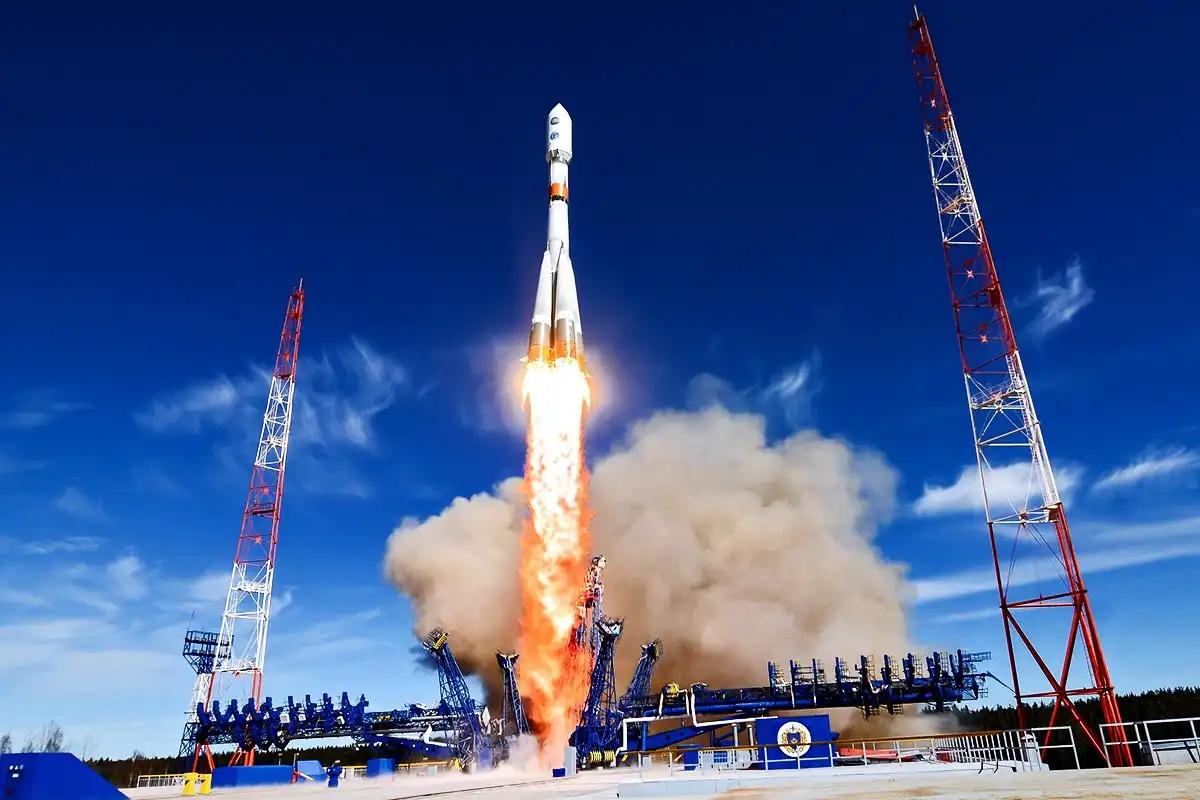
There is one more rocket in operation today that bears the Soyuz name, the Soyuz 2-1v. 2-1v is extremely different from the rest of the Soyuz, or even R-7, family. It uses the same upper stage as Soyuz 2-1b, but not with the classic R-7 core and boosters from the ‘50s. Instead, it has a brand-new first stage, powered by an NK-33, a holdover from the Soviet moon rocket, the N1. This first stage also uses a vernier loosely derived from the Rd-0110. In addition, the 2-1v has a special insertion stage designed for it, known as “Volga,” which is intended to put the payload into high orbits and uses the same storable propellants as Fregat. Volga has also been flown on other Soyuz-2s. Funding for development on Soyuz 2-1v came after a static fire test of a decades-old NK-33. Following complete testing of the first stage, the first launch of this new variant came on December 28, 2013. So far, all of Soyuz 2-1v’s launches have been primarily military in origin. Following four successful launches and one failure, the rocket’s testing period was completed in 2019. After the existing stock of NK-33s is used up, the manufacturers plan to switch to the RD-193, a more modern engine with similar performance.
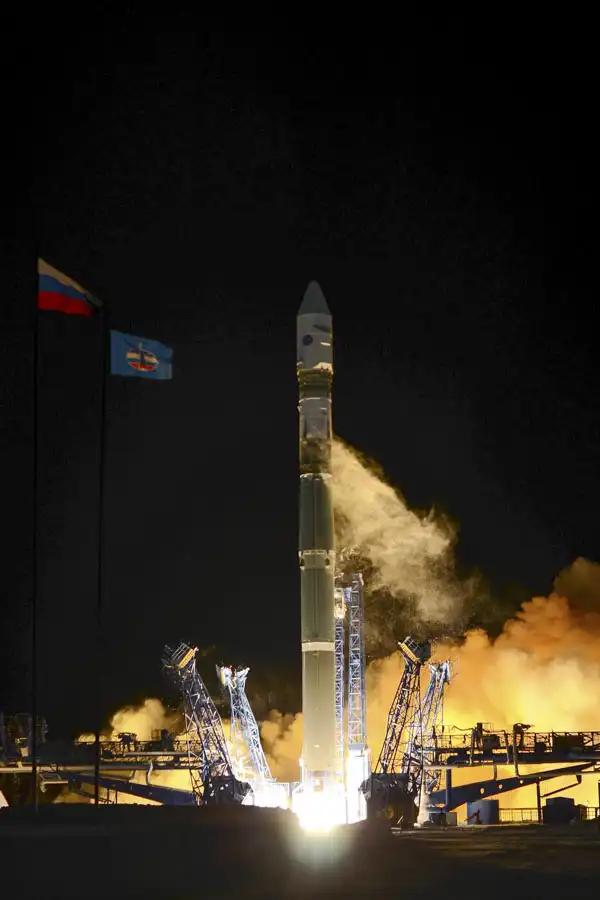
So where does this leave us? Well, as you can see, the development of Soyuz, and the R-7 family in general, has been very conservative. Bold changes in design were not often attempted, with each variant plodding on from the next. At this point, Russia has almost completely transitioned over to Soyuz-2, and it seems that this family of variants will stay for a while. 2-1a will continue to be used for cargo and crew missions to the ISS, while 2-1b will be used for commercial missions. Having just finished testing, it is unclear where 2-1v will fit in. Perhaps it will be a predecessor to a theorized “Soyuz 2-3” featuring a 2-1v core with 2-1a/b boosters, for a serious upgrade to Soyuz. While there are some proposed replacements for the Soyuz, it’s proven hard to cancel this rocket. It will nearly certainly see flights through the 70th year of the R-7 family, and quite possibly could get to the 80th or even 100th. The sight of the classic “Korolev Cross,” the distinctive shape made by the boosters as they separate, recalls those early days of the Soviet space program, a program which is hurtling towards an uncertain future, possibly stagnating without sufficient funding for new development in the face of a wave of new commercial rockets to compete with. Companies like SpaceX and Rocket Lab are now serious contenders for Russian launches. How will Roscosmos adapt? We don’t yet know.